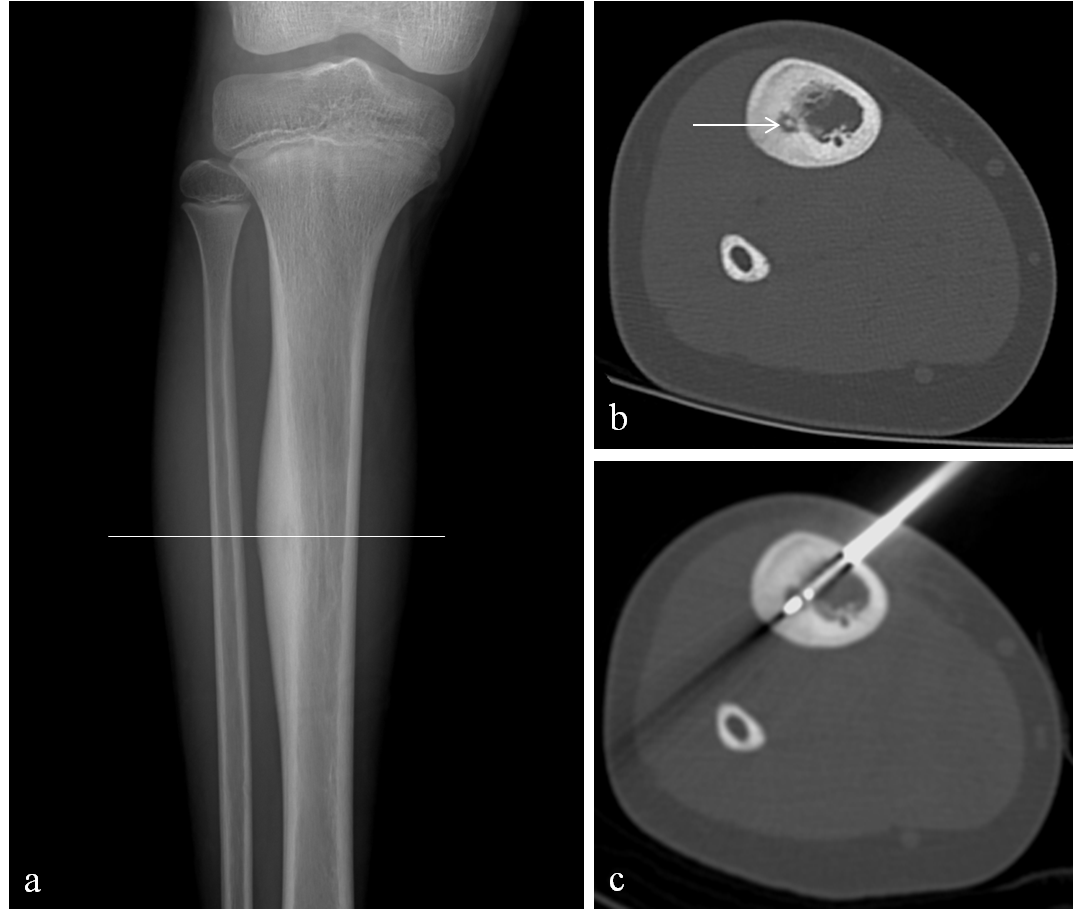Tumor Ablation Program: Spotlight on Osteoid Osteoma
Date Posted: domingo, febrero 01, 2015Over the past ten years, our Department embarked on building an ablation program that was established on four main pillars: one Abdominal Interventional Radiologist, a radiofrequency (RF) ablation system, anesthesiology team support, with surgical and medical oncology services as the main referral base.
In the past 6 years, the tumor ablation service has evolved considerably and in several dimensions:
1). Addition of different thermal ablation modalities, including cryoablation and most recently microwave ablation, to be able to treat a wide spectrum of tumors including primary and metastatic liver and lung cancers, renal cancers, and metastatic bone disease.
2). Additional Interventional Radiologists and faculty from the Musculoskeletal Division with training in interventional radiology joined the tumor ablation team in order to provide a subspecialized service.
3). The referral base has also grown to encompass the liver transplantation team through the Hepatocellular Carcinoma Program, the urology team, and in the past two years the orthopedic oncology team.
4). A clinic was also established to accommodate consultations and improve the pre- and post-operative patient care.
In this issue, we focus on a new addition to the scope of tumors that we are able to treat with RF ablation: the percutaneous RF ablation of osteoid osteoma, in collaboration with the orthopedic oncology team led by Dr. Mathew Most.
Osteoid osteoma is a benign lesion of bone, typically involving children and young adults between 5-25 years old. Despite its benign histologic nature, patients with osteoid osteoma often present with significant dull aching pain and discomfort which may worsen and become severe, especially in the evening. Unfortunately, many patients suffer with this pain for years before either seeking medical care or receiving the correct diagnosis. After clinical assessment, diagnosis is often made on radiographs as a focal area of reactive cortical thickening and sclerosis with a small central lucent nidus (Fig 1a). Occasionally, CT is required to confirm the diagnosis and can be helpful for pre-interventional planning (Fig 1b).
While, over time, cases of osteoid osteoma can be self-limiting, there is often a prolonged clinical course. The symptoms of osteoid osteoma can be managed by NSAIDs, since the nidus produces the prostaglandins that cause the symptoms. Since NSAIDs block prostaglandin production, osteoid osteoma symptoms are classically alleviated with NSAID treatment. Unfortunately, because of the chronic nature of the lesion, nightly NSAIDs are usually required, often leading to suboptimal management of pain or complications from long term NSAID use. Radiofrequency ablation of osteoid osteoma is considered the treatment method of choice in many cases. This minimally invasive procedure involves multiple steps:
1). The procedure is performed under general anesthesia since the nidus of an osteoid osteoma is usually very painful, in addition to the pain induced by the ablation itself.
2). CT scan is used to target the lesion using a coaxial drill needle system that enables tissue biopsy.
3). Next, the appropriate radiofrequency probe will be advanced into the lesion which is heated at 85 to 90 degrees Celsius for 6 minutes (Fig 1c).
The procedure takes approximately 2 hours including induction of general anesthesia. Following the procedure, the patient will be transferred to the recovery room and supervised by the anesthesiology team for approximately 4 hours, before leaving the hospital. Rapid pain relief is expected within 2 to 3 days after the procedure.
“Having the Interventional Radiology team to treat patients with osteoid osteoma tumors is a real asset to this institution,” says Dr. Most. “Prior to the advent of RFA, these pediatric tumors were treated with invasive surgical excision, which would often entail lengthy hospital stays, significant postoperative pain, and weeks to months of recovery and recuperation. Now, patients have the option to receive minimally invasive same-day outpatient treatment with little pain, fast recovery times, and success rates at least as high as traditional open procedures. I have referred several patients to the RFA team for treatment of osteoid osteoma, and fortunately all have done very well – all pain free and completely off of NSAIDS within 1-2 days of the procedure. I especially remember one young man who was having very significant pain for 4 or 5 years. He had an osteoid osteoma in the iliac bone of his pelvis, which was not detected on prior imaging years ago at an outside facility. He bounced around from orthopaedic surgeons to pain management specialists to even psychiatrists to try and treat his symptoms. He was finally re-imaged, and the osteoid osteoma was diagnosed. I referred him to Dr. Karam and the RFA team, and the patient was completely pain free less than 24 hours after the procedure, pain free for the first time in years.”
 Figure 1: 10-year-old boy with right tibia osteoid osteoma (OO). (a): Right leg radiograph demonstrates reactive cortical sclerosis. (b): Axial CT image obtained through the right tibia at the level of the cortical sclerosis (white line in a) demonstrates the OO nidus (arrow) prior to advancing the RFA electrode across the OO (c).
Figure 1: 10-year-old boy with right tibia osteoid osteoma (OO). (a): Right leg radiograph demonstrates reactive cortical sclerosis. (b): Axial CT image obtained through the right tibia at the level of the cortical sclerosis (white line in a) demonstrates the OO nidus (arrow) prior to advancing the RFA electrode across the OO (c).




